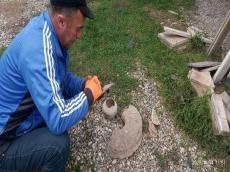|
|
TODAY.AZ / Society
Excavations in Guba lead to discovery of ancient valuable cultural artifacts
24 November 2022 [11:10] - TODAY.AZ

By Azernews
By Sabina Mammadli
The State Service for the Protection, Development, and Restoration of the Cultural Heritage conducts various excavation works in a timely manner.
During the earthworks in the northern Guba District, an 80-cm wall in width was discovered on the territory of the cemetery in Digah village. The discovered ancient artifact was reportedly made of river stones and burnt bricks. Furthermore, various samples of pottery and millstones were also found during the earthworks.
While questioning the locals, the state service acquired information that previously ancient coins, pottery, and other samples of material culture were found in the territory.
The service noted that the territory needs to be comprehensively researched, underscoring that appropriate work is planned to be carried out in the area.
Azerbaijan’s Guba District is well-known for its architectural structures, ancient ruins, fascinating architectural structures, and diverse landscape.
Guba is one of Azerbaijan’s favorite tourist destinations, rich in natural resources and fruitful soil. Its geographic location and the mild climate attract locals and visitors.
The history of the district can be observed in its settlements dating to the XII-XIII centuries, a temple dating back to the IX century, and several XIX-century buildings. Several of these historical buildings are the Juma Mosque, the Sakina Khanum mosque, Ardabil Mosque, and the old hamam.
Numerous archeological excavations have been carried out in all parts of the country for many years. In this way, Azerbaijan has been collaborating with foreign companies to further dive into the country’s monuments. With this aim in mind, the country’s Archaeology, Ethnography and Anthropology Institute and the German Institute of Archeology carried out large-scale archaeological researches in Karabakh.
Some 13 monuments associated with the Lalatapa phenomenon on the Karabakh plain were evaluated, and an archaeological study was conducted on four of them during the 2022 research season, namely the Janavartapa, Sarijali No. 2, Lalatapa, and Farmantapa settlements. Topographic measurements were carried out in these monuments, and 3D models were created based on their drone footage.
Earlier, Azerbaijani and US archaeologists also conducted excavations in the jar burial site in the country’s southern Lerik District.
Such activities and researches allow a closer, deeper look into Azerbaijan’s ancient legacy.
URL: http://www.today.az/news/society/228414.html
 Print version
Print version
Connect with us. Get latest news and updates.
See Also
- 23 April 2025 [11:03]
Six-lane highway takes shape between Heydar Aliyev avenue and Ziya Bunyadov avenue - 22 April 2025 [15:17]
Azerbaijan’s ACG project delivers massive oil and gas returns - 22 April 2025 [13:28]
Condolence book opened following passing of Pope Francis - 22 April 2025 [12:56]
Cultural agency fights against Armenia's misappropriation of heritage - 22 April 2025 [12:02]
ICYF Eurasian Center presents mine victim rights platform at UN ECOSOC Youth Forum - 22 April 2025 [11:27]
Drone-assisted drug smuggling attempt from Iran to Azerbaijan thwarted at border - 21 April 2025 [11:57]
Proposal to establish Turkic World Science Center at Garabagh University - 21 April 2025 [10:21]
Construction of Aghdam-Khankendi highway reaches 72% completion - 19 April 2025 [14:20]
Baku spends over 1 billion manats on education in Q1 - 19 April 2025 [13:45]
Azerbaijan highlights cultural heritage at Rabat Book Fair
Most Popular
 What von der Leyen doesn't know about. Or doesn't want to know
What von der Leyen doesn't know about. Or doesn't want to know
 Culture Minister meets with Kyrgyz counterpart in Bishkek
Culture Minister meets with Kyrgyz counterpart in Bishkek
 Trump sees hope for Ukraine-Russia deal, analysts remain skeptical
Trump sees hope for Ukraine-Russia deal, analysts remain skeptical
 Leyla Aliyeva visits school for visually impaired in Hanoi
Leyla Aliyeva visits school for visually impaired in Hanoi
 Azerbaijan's Chamber of Accounts urges strengthening audits on renewables & green budgeting
Azerbaijan's Chamber of Accounts urges strengthening audits on renewables & green budgeting
 Baku to Host Second Turkic Trade and Investment Forum in June
Baku to Host Second Turkic Trade and Investment Forum in June
 Pakistani PM hails Lahore-Baku direct flights as key milestone
Pakistani PM hails Lahore-Baku direct flights as key milestone
